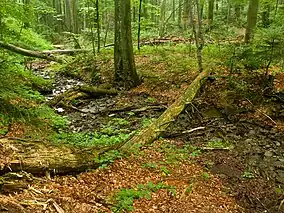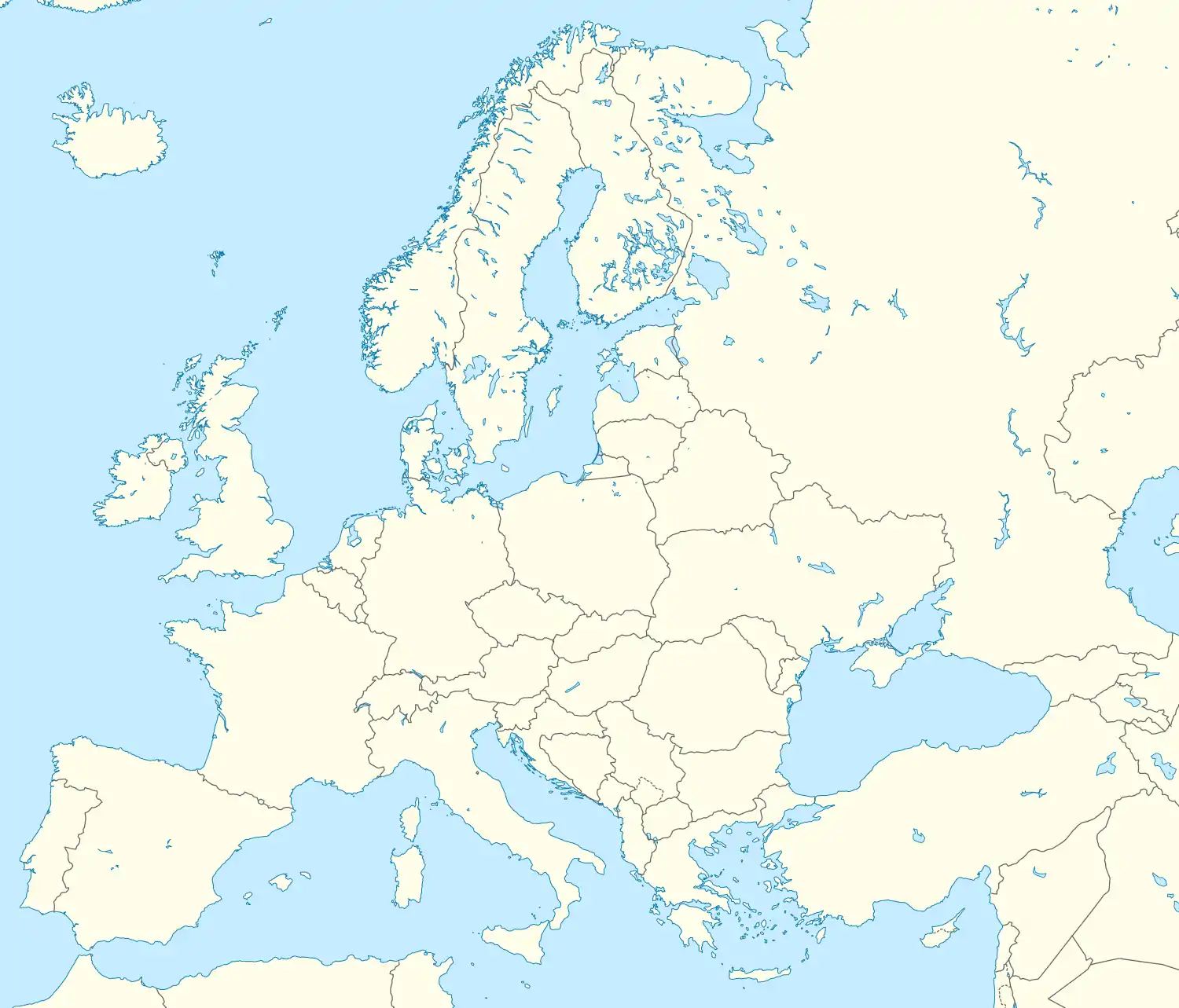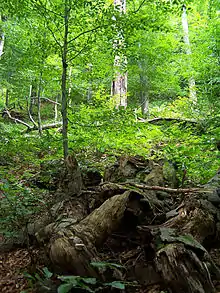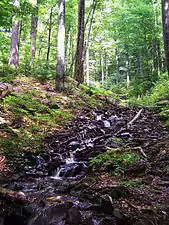Ancient and Primeval Beech Forests of the Carpathians and Other Regions of Europe
Ancient and Primeval Beech Forests of the Carpathians and Other Regions of Europe is a transnational composite nature UNESCO World Heritage site, encompassing forests in 12 European countries.
| UNESCO World Heritage Site | |
|---|---|
 Stužica primeval forest | |
| Location | (see map) |
| Criteria | Natural: |
| Reference | 1133ter |
| Inscription | 2007 (31st session) |
| Extensions | 2011 and 2017 |
The Primeval Beech Forests of the Carpathians include ten separate massifs located along the 185 km (115 mi) long axis from the Rakhiv mountains and Chornohora ridge in Ukraine over the Poloniny Ridge (Slovakia) to the Vihorlat Mountains in Slovakia. The Ancient Beech Forests of Germany include five locations, cover 4,391 hectares and were added in 2011.
The Carpathian site covers a total area of 77,971.6 ha (192,672 acres), out of which only 29,278.9 ha (72,350 acres) are part of the actual preserved area, while the rest is considered a "buffer zone". Primeval Beech Forests of the Carpathians cover areas of Zakarpattia and Prešov Regions. Over 70% of the site is located in Ukraine. The area includes two national parks, and some habitat controlled areas, mostly in Slovakia. Both national parks, along with a neighboring area in Poland, compose a separate biosphere reserve, the East Carpathian Biosphere Reserve. Besides Havešová, Rožok, and Stužica (all of them located in Bukovské vrchy), there is a fourth component situated in Slovakia, named Kyjovský prales of Vihorlat. Ukrainian locations include Chornohora, Kuziy-Trybushany, Maramarosh, Stuzhytsia–Uzhok, Svydovets, and Uholka–Shyrikyi Luh. Only a few of the ten components are accessible to visitors. Stužica is the only one of three locations in Bukovské vrchy (Slovakia) with available hiking trails. In 2017, UNESCO extended the site, adding forests in Albania, Austria, Belgium, Bulgaria, Croatia, Italy, Romania, Slovenia, and Spain.[1][2]
The last intact virgin forest in the temperate latitudes of Europe is to be found in the Carpathians. Trees can live to a hundred years old in these forests, providing an important habitat for organisms such as mushrooms, moss, lichen, insects, rare birds (e.g. capercaillie and black grouse) and mammals (e.g. bats, brown bear, wolf and lynx). Large parts of the forest in the Romanian part of the Carpathians have been lost due to deforestation. The pressure on timber as a resource may increase due to international demand and European companies may start large-scale felling in neighbouring Ukraine. Currently unprotected areas of virgin forest can be permanently preserved in the Ukrainian Carpathians by expanding and reinforcing conservation areas. In the Ukrainian Carpathians there are nine national parks and two biosphere reserves. There is a general ban on tree felling in coniferous forest areas above 1,100 metres. If park administrations are shown to work, management of larger, previously unprotected areas of virgin forest to preserve them on a permanent basis, may occur. There are roughly 100,000 additional hectares of forest which could be integrated into the existing conservation areas.[3]
Forests

| Protected site | Type of natural reserve | Region | Country | Protected area | Buffer zone |
|---|---|---|---|---|---|
| Lumi i Gashit | Valbonë Valley National Park | Kukës | Albania | 1261,52 ha | 8977,48 ha |
| Rrajca | Shebenik-Jablanica National Park | Elbasan | 2129,45 ha | 2569,75 ha | |
| Nationalpark Kalkalpen | Nationalpark Kalkalpen | Upper Austria | Austria | 1867.45 ha[4] | 1545.05 ha[4] |
| Dürrenstein Forest | Dürrenstein Forest | Lower Austria, Styria | 2946.2 ha[4] | 14197.24 ha[4] | |
| Sonian Forest | Sonian Forest | Brabant | Belgium | 269,31 ha | 4650,86 ha |
| Central Balkan National Park | Central Balkan National Park | central Balkan Mountains | Bulgaria | 10988,91 ha | 11720,85 ha |
| Paklenica National Park | Paklenica National Park | Lika-Senj, Zadar | Croatia | 2031,78 ha | 810,11 ha |
| Hajdučki and Rožanski strict reservations | Northern Velebit National Park | Lika-Senj | 1289,11 ha | 9869,25 ha | |
| Jasmund | Jasmund National Park | Mecklenburg-Vorpommern | Germany | 492,5 ha | 2510,5 ha |
| Serrahn | Müritz National Park | 268,1 ha | 2568 ha | ||
| Grumsiner Forest | Grumsiner Forest Nature Reserve | Brandenburg | 590,1 ha | 274,3 ha | |
| Hainich | Hainich National Park | Thuringia | 1573,4 ha | 4085,4 ha | |
| Kellerwald | Kellerwald-Edersee National Park | Hesse | 1467,1 ha | 4271,4 ha | |
| Cervara Valley | Parco Nazionale d'Abruzzo, Lazio e Molise | Abruzzo | Italy | 119,7 ha | 751,61 ha |
| Moricento Forest | 192,7 ha | 751,61 ha | |||
| Coppo del Morto | 104,71 ha | 415,51 ha | |||
| Coppo del Principe | 194,49 ha | 446,62 ha | |||
| Val Fondillo | 325,03 ha | 700,95 ha | |||
| Cozzo Ferriero | Pollino National Park | Calabria, Basilicata | 95,74 ha | 482,61 ha | |
| Foresta Umbra | Gargano National Park | Apulia | 182,23 ha | 1.752,54 ha | |
| Cimino Mount | Cimino Mount | Abruzzo, Lazio | 57,54 ha | 87,96 ha | |
| Raschio Mount | Regional Natural Park of the Bracciano-Martignano lake complex | Lazio | 73,73 ha | 54,75 ha | |
| Sasso Fratino | Foreste Casentinesi, Monte Falterona, Campigna National Park | Emilia-Romagna, Tuscany | 781,43 ha | 6.936,64 ha | |
| Cheile Nerei-Beușnița | Cheile Nerei-Beușnița National Park | Caraș-Severin | Romania | 4292,27 ha | 5959,87 ha |
| Şinca secular forest | Şinca secular forest | Brașov | 338,24 ha | 445,76 ha | |
| Slătioara secular forest | Slătioara secular forest | Suceava | 609,12 ha | 429,43 ha | |
| Cozia | Cozia National Park | Vâlcea | 109,58 ha | 14253 ha | |
| Domogled – Valea Cernei | Domogled-Valea Cernei National Park | Mehedinți, Caraș-Severin, Gorj | 9732,26 ha | 51461,28 ha | |
| Groșii Țibleșului | Groșii Țibleșului National Park | Maramureș | 346,37 ha | 563,57 ha | |
| Izvoarele Nerei | Semenic-Cheile Carașului National Park | Caraș-Severin | 4677,21 ha | 2494,83 ha | |
| Strîmbu Băiuț | Strîmbu Băiuț National Park | Maramureș | 598,14 ha | 713,09 ha | |
| Stužica – Bukovské vrchy | Poloniny National Park* | Prešov | Slovakia | 2950 ha | 11300 ha |
| Rožok | Preserved areas of Prešov | 67,1 ha | 41,4 ha | ||
| Vihorlat | 2578 ha | 2413 ha | |||
| Havešová | 171,3 ha | 63,9 ha | |||
| Forest reserve of the Virgin Forest of Krokar | Forest reserve of the Virgin Forest of Krokar | Kočevje | Slovenia | 74,50 ha | 47,90 ha |
| Snežnik–Ždrocle forest reserve | Snežnik–Ždrocle forest reserve | Ilirska Bistrica, Loška Dolina | 720,24 | 128,80 | |
| Tejera Negra Beech | Sierra Norte de Guadalajara Natural Park | Castile-La Mancha | Spain | 255,52 ha | 13880,86 ha |
| Montejo Beech | Beech area of Montejo de la Sierra | Community of Madrid | 71,79 ha | 13880,86 ha | |
| Lizardoia Integral Reserve | Irati Forest | Navarre | 63,97 ha | 24494,52 ha | |
| Aztaparreta | Integral Reserve of the Ravine of Aztaparreta | 171,06 ha | 24494,52 ha | ||
| Cuesta Fría Beech | Ayllón | Castile and León | 213,65 ha | 14253 ha | |
| Canal de Asotín | Picos de Europa National Park | 109,58 ha | 14253 ha | ||
| Chornohora | Carpathian Biosphere Reserve | Zakarpattia | Ukraine | 2476,8 ha | 12925 ha |
| Uholka – Shyrikyi Luh | 11860 ha | 3301 ha | |||
| Svydovets | 3030,5 ha | 5639,5 ha | |||
| Maramarosh | 2243,6 ha | 6230,4 ha | |||
| Kuziy – Trybushany | 1369,6 ha | 3163,4 ha | |||
| Stuzhytsia – Uzhok | Uzhanian National Nature Park | 2532 ha | 3615 ha | ||
| Gorgany | Gorgany Nature Reserve | Ivano-Frankivsk | 753,48 ha | 4637,59 ha | |
| Roztochya | Roztochya Biosphere Reserve | Lviv | 384,81 ha | 598,21 ha | |
| Satanіvska Dacha | Podilski Tovtry National Nature Park | Khmelnytskyi | 212,01 ha | 559,37 ha | |
| Synevyr | National Nature Park Synevir | Zakarpattia | 2865,04 ha | 2181,74 ha | |
| Zacharovanyi Krai | Zacharovany Krai National Nature Park | 1258,13 ha | 1275,44 ha |
* – Most of the Slovak components of the World Heritage site are situated in the Poloniny National Park in the easternmost and also the least populated part of the country. The National Park was created on 1 October 1997 with a protected area of 298.05 km² and a buffer zone of 109.73 km².
Tentative list
In 2018 and 2019, several more forests were placed on the World Heritage Tentative list as a proposal for the expansion of the Ancient and Primeval Beech Forests of the Carpathians and Other Regions of Europe site. Forests included on the Tentative list are:
- Nature Reserve “Vinatovača”
- Strict Nature Reserve “Busovata”
- Strict Nature Reserve “Felješana”
- Strict Nature Reserve “Kukavica”
- Strict Nature Reserve “Golema reka”
- Nature Reserve “Danilova kosa”
- Strict Nature Reserve “Iznad Tatalije”
- Strict Nature Reserve “Zelenika”
- Strict Nature Reserve “Zeleničje”
- Special Nature Reserve “Mala Jasenova Glava”
- Strict Nature Reserve “Vrh Željina-Pločka Čuka”
- Fruška gora cluster (Level I Protection Regime localities "Papratski do" and "Ravne")
- Tara National Park
- Level I Protection Regime locality "Zvezda"
- Level I Protection Regime locality "Klisura Rače"
- Kopaonik National Park
- Level I Protection Regime locality "Kozije stene"
- Duboka i Brzećka reka cluster (Level I Protection Regime localities "Metođe", "Jelak" and "Duboka")
In Montenegro[7]
- Virgin Forest Reserve in NP Biogradska Gora
In Switzerland[8]
- Forêt de la Vallée de Lodano
- Forêt de la Bettlachstock
In Bosnia and Herzegovina[9]
- Strict Nature Reserve - Primeval forest "Janj"
In Poland[10]
- The forest of the primeval character in the Bieszczady National Park
In North Macedonia[11]
- Beech forest Dlaboka Reka - Mavrovo National Park
In Italy[12]
- “Pollinello” (Extension of Cozzo Ferriero component, Pollino National Park)
- “Foresta Umbra” (Gargano National Park)
- “Valle Infernale” (Aspromonte National Park)
- “Foresta del Cansiglio”
In Slovakia[13]
- Stužica – Bukovské vrchy
- Udava
- Havešová Primeval Forest
- Rožok
- Vihorlat
- Kyjovský prales
In Czechia[14]
- Jizera Mountains Beech Forest National Nature Reserve
In France[15]
- Aigoual biological strict reserves
- Chapitre- Petit-Buech biological strict reserve
- Fontainebleau biological strict reserves cluster - Tillaie, Gros-Fouteau, Chene Brule, Gorge aux Loups, Vallee Jauberton, Beorlots, Rocher de Ia Combe
- Massane and Moixoses reserves
- Py-Pas de Rotja national natural reserve
- Sainte-Baume biological strict reserve
- Saint-Pe-de-Bigorre biological strict reserve
- Sylve d'Argenson biological strict
Gallery
 Forest in Stuzica
Forest in Stuzica Havešová
Havešová Stužica
Stužica Freshwater stream in Stužica
Freshwater stream in Stužica Stužica
Stužica
References
- Centre, UNESCO World Heritage. "Ancient and Primeval Beech Forests of the Carpathians and Other Regions of Europe". UNESCO.
- "Unesco approves the extension of the Carpathian Primary Beech forests".
- "Protecting virgin forest in the Ukrainian Carpathians".
- Centre, UNESCO World Heritage. "Ancient and Primeval Beech Forests of the Carpathians and Other Regions of Europe". UNESCO World Heritage Centre. Retrieved 1 June 2019.
- "Ancient and Primeval Beech Forests of the Carpathians and Other Regions of Europe (Serbia)". UNESCO. Retrieved 3 July 2018.
- "Ancient and Primeval Beech Forests of the Carpathians and Other Regions of Europe - extension (Serbia)". UNESCO. Retrieved 6 January 2020.
- "Ancient and Primeval Beech Forests of the Carpathians and Other Regions of Europe (Montenegro)". UNESCO. Retrieved 3 July 2018.
- "Forêts primaires et anciennes de hêtres des Carpates et d'autres régions d'Europe (Switzerland)". UNESCO. Retrieved 3 July 2018.
- "Ancient and Primeval Beech Forests of the Carpathians and Other Regions of Europe - extension (Bosnia and Herzegovina)". UNESCO. Retrieved 6 January 2020.
- "Ancient and Primeval Beech Forests of the Carpathians and Other Regions of Europe - extension (Poland)". UNESCO. Retrieved 6 January 2020.
- "Ancient and Primeval Beech Forests of the Carpathians and Other Regions of Europe - extension (North Macedonia)". UNESCO. Retrieved 6 January 2020.
- "Ancient and Primeval Beech Forests of the Carpathians and Other Regions of Europe - extension (Italy)". UNESCO. Retrieved 6 January 2020.
- "Ancient and Primeval Beech Forests of the Carpathians and Other Regions of Europe - extension (Slovakia)". UNESCO. Retrieved 6 January 2020.
- "Ancient and Primeval Beech Forests of the Carpathians and Other Regions of Europe - extension (Czechia)". UNESCO. Retrieved 6 January 2020.
- "Ancient and Primeval Beech Forests of the Carpathians and Other Regions of Europe - extension (France)". UNESCO. Retrieved 6 January 2020.
External links
| Wikimedia Commons has media related to Ancient and primeval beech forests of the Carpathians and other regions of Europe. |
- "Ancient and Primeval Beech Forests of the Carpathians and Other Regions of Europe". UNESCO World Heritage Centre. Retrieved 28 September 2008.
- Beauty and changes of Primeval beech forests throughout a year
